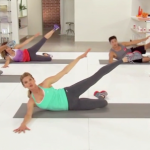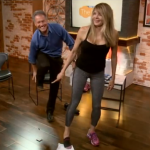The Right Way to Stretch
learn how to stretch to get the best out of your routine
When we talk about exercise, we usually focus on what happens during the workout: The proper form, the number of repetitions, engaging the correct muscles, and so on – all elements of a successful routine. But, if you’re not following the right steps before and after you exercise, you might just be sabotaging your results and causing pre- and post- workout stress to your body.
Let’s take a closer look as to why stretching is so important and why using the right warm-up and cool-down are so crucial:
Warming up can work wonders. People often get confused about the concept of warm-ups. Sure, it seems simple enough – do some stretches, jog around a bit, and get moving. But, a proper warm up can mean the difference between getting limber, achieving peak performance with a full range of motion… or, running the risk of injury.
The trick to a successful warm-up is choosing movements that will mimic the range of motion you’ll use in the activity you’re preparing to do. If you’re about to go for a run, for example, your warm-up might start with a brisk walk to loosen up muscles and joints, followed by a light jog, gradually building up to a more challenging pace. And, regardless of what exercise you’re doing, remember: The more intense you intend your workout to be, the longer (and more thorough) your warm-up should be.
When and how-to stretch. Research has suggested that certain types of stretching before a workout may actually do more harm than good. Last year, the American College of Sports Medicine advised against it prior to workouts or competitions. But, when people hear about those studies, they’re often confused: “Does this mean stretching is actually bad? Okay, guess I’ll skip it altogether.” In order to understand the value of stretching, you have to understand the difference between static stretching and dynamic stretching.
“Static Stretching” is the definition of what generally comes to mind when we imagine stretching: Holding a pose for a long period of time. It’s key to avoiding injury because it transports oxygen to the limbs and removes the waste product your cells produce during activity. That means less soreness, improved flexibility and a restored sense of calm. One thing static stretching does not do, however, is adequately warm the muscle. That’s why it’s important to do this type of stretching after your workout. To take those stretches to the next level, grab a stretching strap (like the one found in my Body Blast Kit). Elastic straps are great. They are lightweight tools that let you use your upper body strength to stretch your lower body more easily (and vice versa).
“Dynamic Stretching,” on the other hand, is good to do before exercise. These stretches are actually specific movements that loosen up muscles, increasing blood flow and body temperature.
Don’t forget to refuel. Eating within 90 minutes following exercise is important to replace your glycogen stores and help rebuild muscle tissue. A combination of protein and carbs will help speed up your recovery time, and increase your strength before your next workout. That’s why I’m such a fan of protein shakes. The right mix of whey protein and fruit makes a light but satisfying post-workout snack. They’re chock full of amino acids (which increase the rate of building muscle), and may be easier to digest after exercise than whole foods. In my next newsletter, we’ll dig deeper into the power of protein shakes (including some delicious recipes), so stay tuned.
Now that you’re prepared for the pre- and post- activities of a workout, go out and get the best of your routine. Whether you’re working out to some of my DVDs or getting ready for a MP3 walking routine, stretching can ensure you get the best out of your workout.









you didn’t explain what Dynamic Stretching is?
great
Can a warm-up walk before a run be considered Dynamic Stretching?